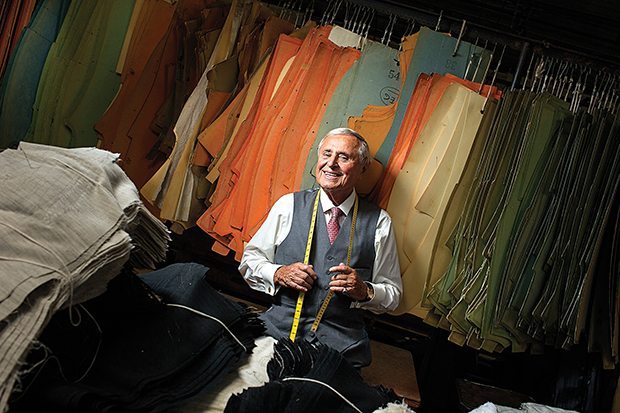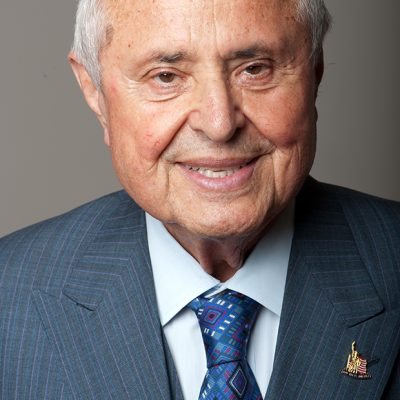
For more than 60 years, this East Williams burg master tailor has made custom clothing for presidents, Hollywood royalty, and those simply seeking to wear something remarkable
by Martin Greenfield, with Wynton Hall
Clothing saved Martin Greenfield’s life.
A Holocaust survivor, one of Brooklyn’s most esteemed tailors and suit makers was laboring in a clothing shop in the Auschwitz concentration camp when he accidentally ripped an SS officer’s shirt. After being beaten for the offense, the soldier threw the shirt at Greenfield. Rather than throw it away, he decided to wear it rather than the standard issue prisoner uniform, and from that moment on, “the guards and prisoners began treating me with respect,” he recalled. Greenfield feels he owes his survival to that additional respect. In 1947, the young clothing worker was hired by the custom-made suit manufacturer GGG Clothiers in East Williamsburg. Over time, he grew in knowledge and inspiration, and ultimately went on to buy the business. Martin Greenfield Clothiers has in the succeeding four decades established itself as perhaps the boroughs most famed maker of fine men’s clothing, and names Presidents like Gerald Ford, Bill Clinton, and Barack Obama among its clientele, along with a roster of celebrities including Paul Newman, Patrick Ewing, and former Mayor Michael Bloomberg. The business also creates custom suits for HBO’s Boardwalk Empire production, and has acted as to tailor for men’s suit lines for both DKNY and Rag & Bone. Greenfield, along with his sons Jay and Tod, still operates the bespoke custom suit wing of the business, with individual appointments available to those who want to look like Hollywood royalty, even if it’s only in their dreams.
—Matt Scanlon
In 1977, exactly thirty years after I arrived in America and found work as a floor boy, I bought the GGG factory at 239 Varet Street in Brooklyn for one hundred thousand dollars. The facility and equipment were mine, the GGG brand was not. I would build a new brand from scratch, step by step, picking the people and systems I wanted. I called it Martin Greenfield Clothiers.
We started with six people. I wanted a business where I touched every suit and served as an architect of the human form. Originally, I envisioned a smaller operation that would turn out a hundred suits a week. My boutique-scale vision died hard and fast. The phone started ringing off the hook. A men’s store in Philadelphia named Diamonds wanted us to hand tailor their suits. Then Neiman Marcus called. They wanted me to do trunk shows and handle their made-to-measure clients. The suits would have Neiman Marcus on the joker tag but would be hand-tailored by us.
My newfound creativity and managerial freedom allowed me to set up smarter systems and do things right. I refused to compromise. We would use only the highest-quality materials and methods.
Mysuits would feature my hand-shaped full canvas fronts, Italian and English woolens and cashmeres, handmade horn buttons affixed with a smart button stance, endless hand pressing to mold the jacket’s form, hand-stitched and functional buttonholes, and collars with a gorge done right to ensure a snug fit around the shirt collar. And above all, only over my dead body would any suit made by Martin Greenfield ever feature fused or glued interlining.
A suit jacket has three layers of fabric: inside, outside, and an interior canvas layer. In a handmade suit, the interior layer floats freely between the inside and the outside. That’s what gives a jacket verve. Cheap suits fuse or—heaven forbid— glue the middle layer to the front layer. The result is a disgusting mess of a suit. When I’m walking down the sidewalk and see a fused or glued jacket, I cross the street so I don’t have to look at it. It’s a rumpled, misshapen sartorial atrocity. That doesn’t happen with properly constructed free-floating canvas. Not the way I do them. My suits drape the body.
In addition to setting soaring manufacturing standards, I also insisted that Martin Greenfield Clothiers’ private clients receive a personalized customer experience. It made good business sense, but it made even better tailoring sense. One of the many advantages of a custom suit over ready-made is that I am able to correct for a customer’s physical imperfections or irregularities. Uneven arms? I correct for them by modifying the sleeves. Longer than normal torso? I change the drop and button stance. Drooping shoulder? I reconstruct the shoulders and make them symmetrical.
I also insisted that we understand each customer’s way of life and professional work. For example, when we dressed a Walter Cronkite, Conan O’Brien, or Stone Phillips, we wouldn’t use the same fabrics that we’d use for a professional athlete like LeBron James, Patrick Ewing, or Shaquille O’Neal. Television cameras hate certain patterns and sheens, whereas athletic, muscular bodies hate tight seams. I was determined to make sure that the corporate culture of my business put a premium on personalized customer communication.
A suit jacket has three layers of fabric: inside, outside, and an interior canvas. In a handmade suit, the interior layer floats freely between the inside and the outside. That’s what gives a jacket verve. Cheap suits fuse or—heaven forbid—glue the middle layer to the front layer.
Dressing Jimmy Fallon
One of the sweetest souls in show business is Brooklyn’s own Jimmy Fallon, a true blue New Yorker and a diehard rag & bone fan to boot. My rag & bone boys, Marcus and David, introduced me to Jimmy in 2009 when he got his first gig with NBC taking over for Conan O’Brien, whom we also dressed, on the Late Night show.
“Jimmy,” said Marcus, “I want you to meet the one and only Mr. Martin Greenfield.”
“Such an honor to meet you, sir,” said Jimmy. He had a sincerity and genuineness that let you know he meant it. I loved the kid the minute I met him.
“What kind of suits are your stylists putting you in right now?” I asked.
“It’s a lot of Italian designer suits,” said Jimmy. “They look good but the fit is so tight that I can’t move around on stage.” I thumbed through the rack of suits and saw all the usual labels and understood the problem immediately. I showed him a few of our samples. He loved the shorter jackets, higher armholes, and slender lapels. “Here’s what we’re going to do,” I told him. “I’m going to give you this rag & bone look you love but with the comfort and flexibility you need each night to do your show.”
“That’s awesome.”
“I’ve seen your show. You like to jump around all over the place. You do that in those suits over there and you’ll break an ankle,” I joked. He laughed and said he couldn’t wait to see what we could do for him.
When Jay, Joe, and I returned for the fitting a week later, Jimmy was beside himself. After trying on several of the made-to-measure suits we made for him, he knelt on one knee and started kissing my ring. “I’m not the pope, Jimmy. I just make your suits,” I said.
“To me, Mr. Greenfield, you’re the pope of fashion.” When Jimmy got the call to take over for Jay Leno, he did the right thing: he brought the show back to New York like a good Brooklyn boy. He also put in an order with us for six more suits. Every time Jay and I visit him for a fitting, true to form, Jimmy gets on one knee and kisses my ring. No ego, all class. Jimmy’s going to do a beautiful job with the new gig and make Brooklyn proud.
Adapted from Measure of a Man: From Auschwitz Survivor to Presidents’ Tailor, by Martin Greenfield, with Wynton Hall (Regnery Publishing, 2014)
Martin Greenfield Clothiers
239 Varet St.
718.497.5480
greenfieldclothiers.com






